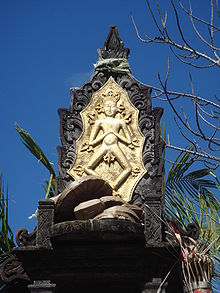

Hyang (Kawi, Sundanese, Javanese, and Balinese) is a representation of the supreme being, in ancient Java and Bali mythology.[1] The spiritual entity can be either considered divine or ancestral. The reverence for this spiritual entity can be found in the folk religions of Java and Bali, such as the Sunda Wiwitan (a.k.a. Sundanism or Cigugur Sundanism), Kejawen (a.k.a. non-monotheistic Javanism), Kapitayan (a.k.a. monotheistic Javanism), and Gama Tirta (a.k.a. Balinism). The realm where Hyang resides is called the Kahyangan, which is an Old Javanese term that means "the abode of Hyang", "part of Hyang", or "heaven".[2]
The Old Sundanese manuscript Sanghyang Siksa Kandang Karesian,[3] has stated that Hyang can be interpreted as "Omnipotence". Similarly, in the highest Sunda Wiwitan Spirituality, Hyang is also referred to as Sang Hyang Kersa (the Powerful).[4]
Gama Tirta a.k.a. Balinism describes Hyang as a venerated spiritual existence that deserves special reverence. Hyang is commonly described as a sacred and luminous personal form. It is also referred to as the name for a spiritual existence that has supernatural powers, portrayed like the sun in a dream and often mentioned in a masculine form. A Hyang's arrival in a person's life is reputed to give great contentment and happiness to the person. Indonesians generally recognize this term to refer to the cause of beauty, the cause of all existence (creator), or simply to refer to God.[1]
In Kejawen a.k.a. Javanism, the concept of the monotheistic God is described as the Sang Hyang Tunggal or Sang Hyang Wenang. Raden Ngabehi Ranggawarsita in his book, Paramayoga, detailed the names and designations for Javanese concept of God as the objective of worship, including Sang Hyang Suksma Kawekas, Sang Hyang Suksmesa, Sang Hyang Amurbeng Rat, Sang Hyang Sidhem Permanem, Sang Hyang Maha Luhur, Sang Hyang Wisesaning Tunggal, Sang Hyang Wenanging Jagad, Sang Hyang Maha Tinggi, Sang Hyang Manon, Sang Hyang Maha Sidhi, Sang Hyang Warmana, Sang Hyang Atmaweda, etc.[5]
- ^ a b "Penjelasan Lengkap Acintya (Sang Hyang Widhi atau Sang Hyang Tunggal) - Mantra Hindu Bali". Mantra Hindu Bali (in Indonesian). 2015-12-17. Archived from the original on December 25, 2015. Retrieved 2018-07-13.
- ^ Zoetmulder, P.J. (1982), Old Javanese-English Dictionary, Koninklijk Instituut voor Taal-, Land- en Volkenkunde
- ^ Piliang, Santo Saba (2020-06-14). LEMURIA INDONESIA (in Indonesian). Santo Saba Piliang.
- ^ Tempo: Indonesia's Weekly News Magazine. Arsa Raya Perdana. 2006.
- ^ Fadhil Nugroho Adi (2018-08-23). "Konsep Ketuhanan Menurut Ajaran Kejawen - suaramerdeka.com". www.suaramerdeka.com (in Indonesian). Retrieved 2020-04-21.
